Outsourcing of Manufacturing Unit Report
VerifiedAdded on 2020/03/07
|17
|4074
|68
Report
AI Summary
This report analyzes the outsourcing potential of Raque Food Systems, comparing Malaysia and Mexico as candidates for relocating manufacturing operations. It discusses economic factors, infrastructure, labor markets, and trade policies, ultimately recommending Malaysia as the more favorable option due to its stable economy, skilled labor, and investor-friendly policies.
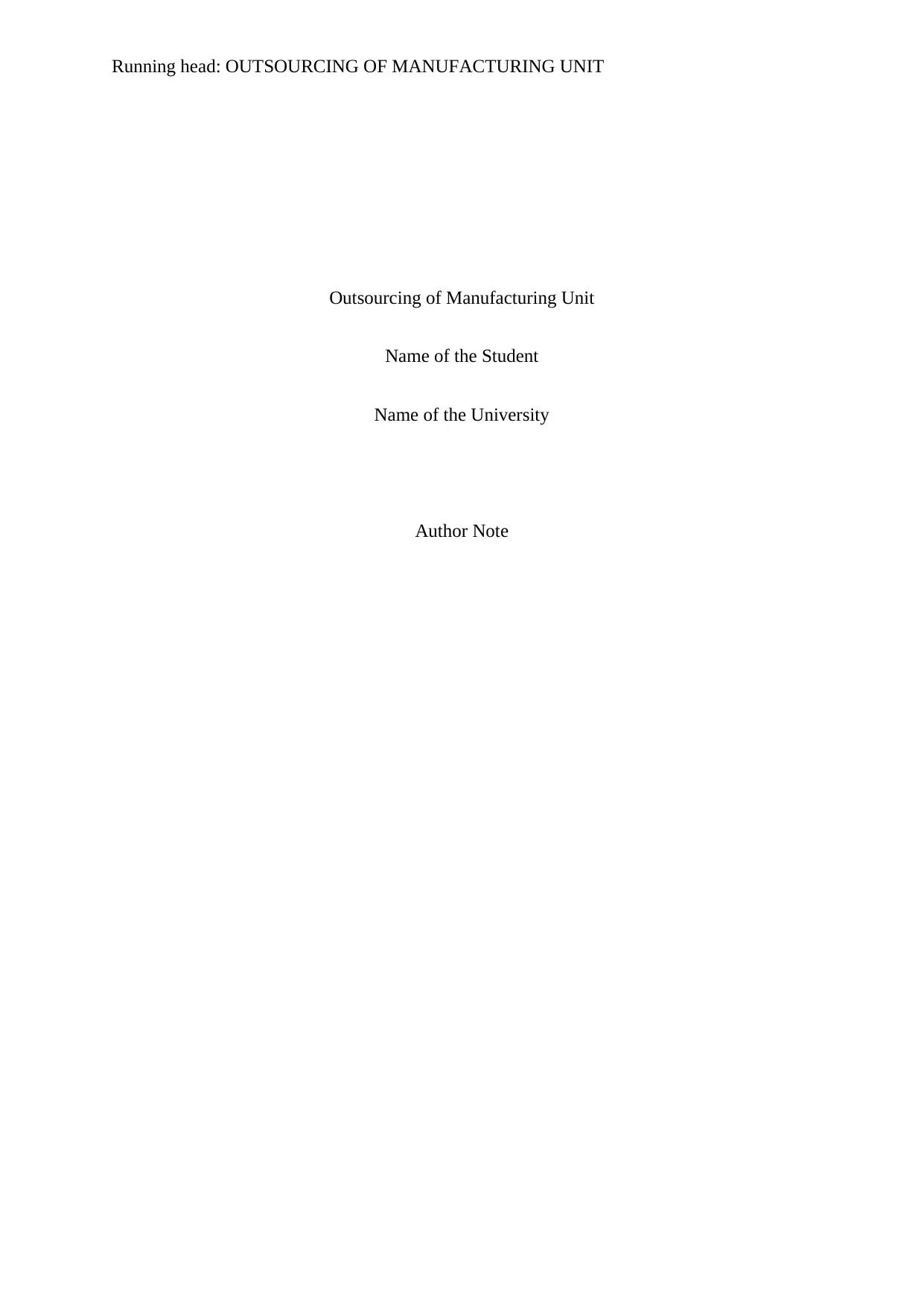
Running head: OUTSOURCING OF MANUFACTURING UNIT
Outsourcing of Manufacturing Unit
Name of the Student
Name of the University
Author Note
Outsourcing of Manufacturing Unit
Name of the Student
Name of the University
Author Note
Paraphrase This Document
Need a fresh take? Get an instant paraphrase of this document with our AI Paraphraser
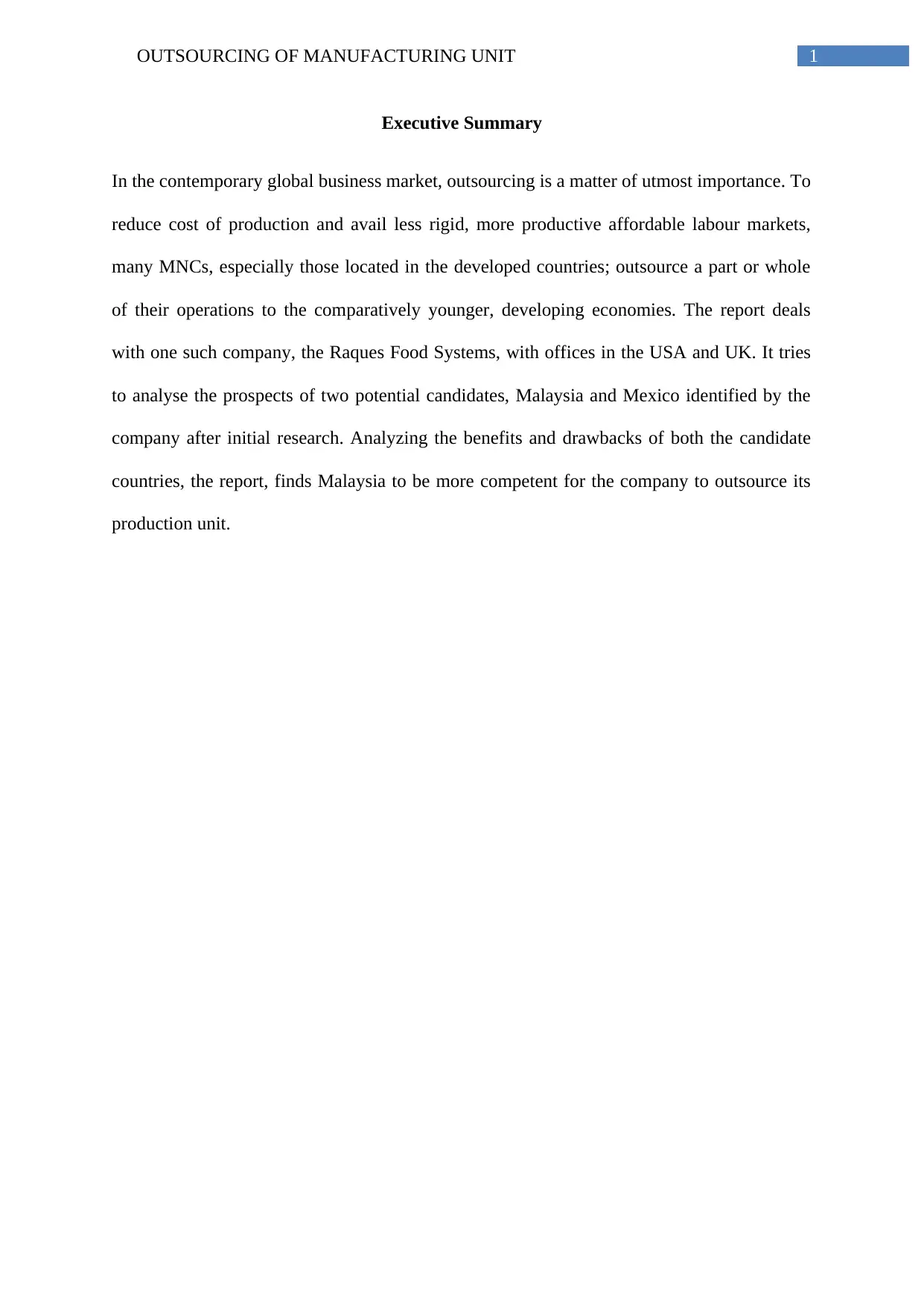
1OUTSOURCING OF MANUFACTURING UNIT
Executive Summary
In the contemporary global business market, outsourcing is a matter of utmost importance. To
reduce cost of production and avail less rigid, more productive affordable labour markets,
many MNCs, especially those located in the developed countries; outsource a part or whole
of their operations to the comparatively younger, developing economies. The report deals
with one such company, the Raques Food Systems, with offices in the USA and UK. It tries
to analyse the prospects of two potential candidates, Malaysia and Mexico identified by the
company after initial research. Analyzing the benefits and drawbacks of both the candidate
countries, the report, finds Malaysia to be more competent for the company to outsource its
production unit.
Executive Summary
In the contemporary global business market, outsourcing is a matter of utmost importance. To
reduce cost of production and avail less rigid, more productive affordable labour markets,
many MNCs, especially those located in the developed countries; outsource a part or whole
of their operations to the comparatively younger, developing economies. The report deals
with one such company, the Raques Food Systems, with offices in the USA and UK. It tries
to analyse the prospects of two potential candidates, Malaysia and Mexico identified by the
company after initial research. Analyzing the benefits and drawbacks of both the candidate
countries, the report, finds Malaysia to be more competent for the company to outsource its
production unit.
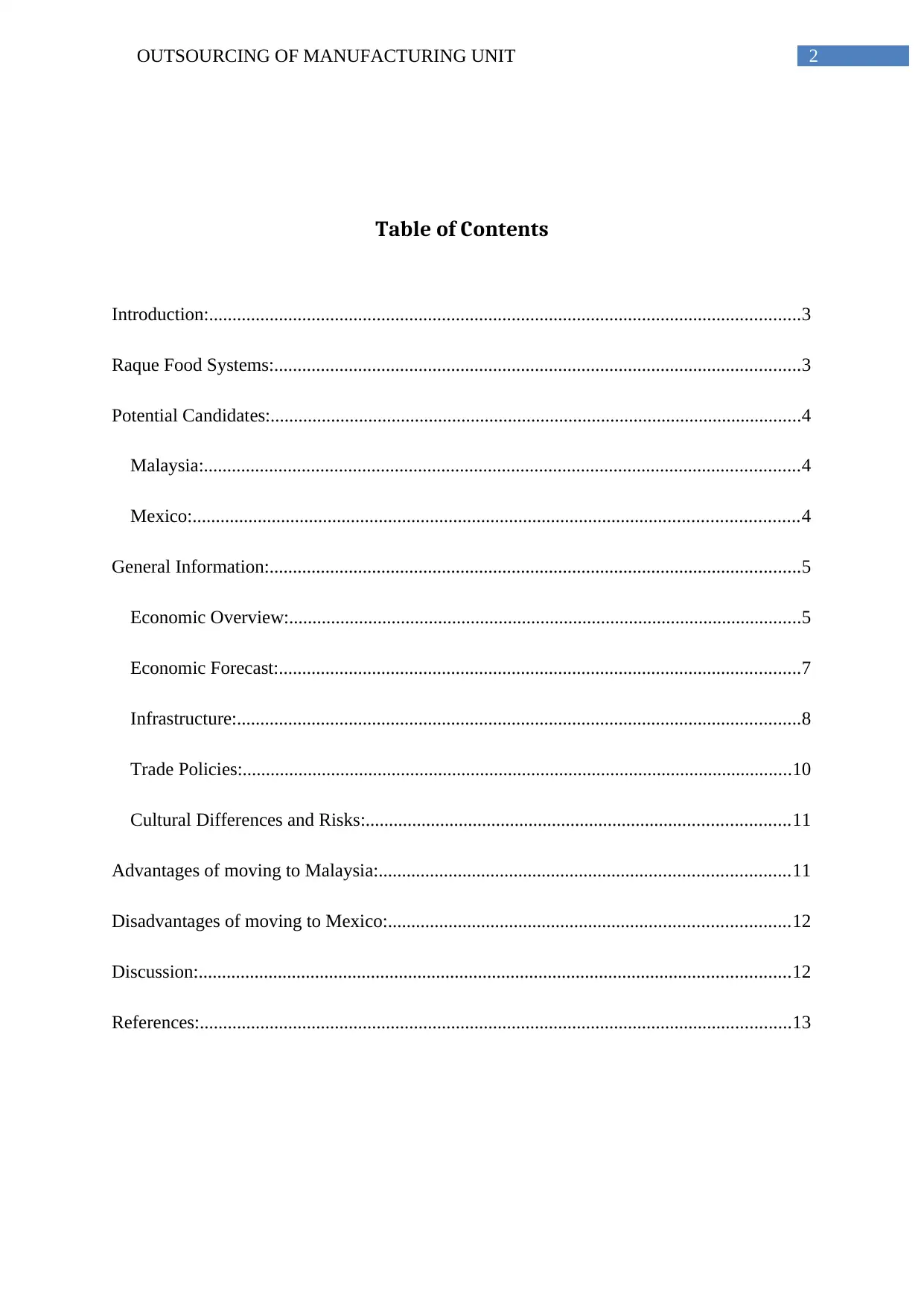
2OUTSOURCING OF MANUFACTURING UNIT
Table of Contents
Introduction:...............................................................................................................................3
Raque Food Systems:.................................................................................................................3
Potential Candidates:..................................................................................................................4
Malaysia:................................................................................................................................4
Mexico:..................................................................................................................................4
General Information:..................................................................................................................5
Economic Overview:..............................................................................................................5
Economic Forecast:................................................................................................................7
Infrastructure:.........................................................................................................................8
Trade Policies:......................................................................................................................10
Cultural Differences and Risks:...........................................................................................11
Advantages of moving to Malaysia:........................................................................................11
Disadvantages of moving to Mexico:......................................................................................12
Discussion:...............................................................................................................................12
References:...............................................................................................................................13
Table of Contents
Introduction:...............................................................................................................................3
Raque Food Systems:.................................................................................................................3
Potential Candidates:..................................................................................................................4
Malaysia:................................................................................................................................4
Mexico:..................................................................................................................................4
General Information:..................................................................................................................5
Economic Overview:..............................................................................................................5
Economic Forecast:................................................................................................................7
Infrastructure:.........................................................................................................................8
Trade Policies:......................................................................................................................10
Cultural Differences and Risks:...........................................................................................11
Advantages of moving to Malaysia:........................................................................................11
Disadvantages of moving to Mexico:......................................................................................12
Discussion:...............................................................................................................................12
References:...............................................................................................................................13
⊘ This is a preview!⊘
Do you want full access?
Subscribe today to unlock all pages.

Trusted by 1+ million students worldwide
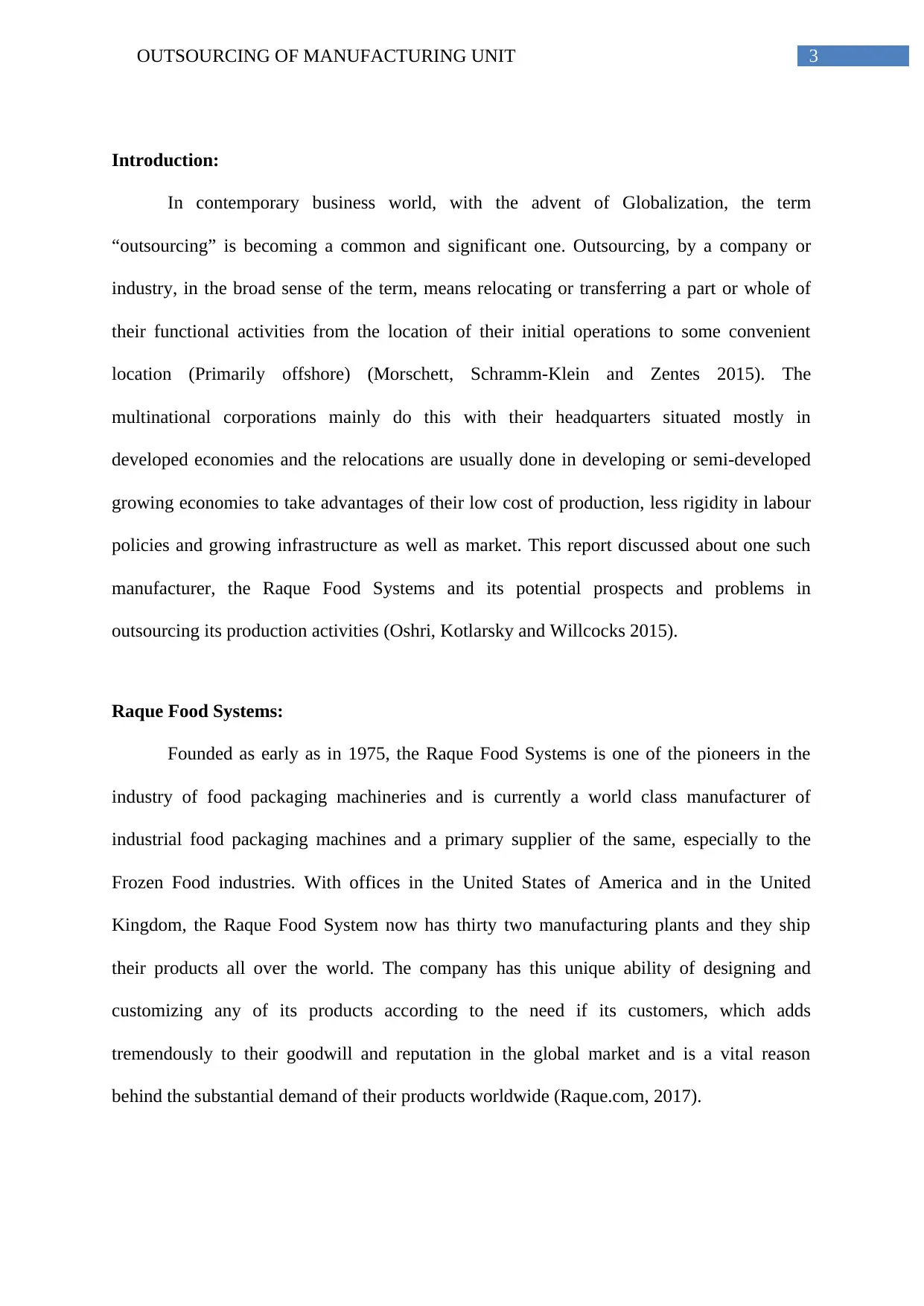
3OUTSOURCING OF MANUFACTURING UNIT
Introduction:
In contemporary business world, with the advent of Globalization, the term
“outsourcing” is becoming a common and significant one. Outsourcing, by a company or
industry, in the broad sense of the term, means relocating or transferring a part or whole of
their functional activities from the location of their initial operations to some convenient
location (Primarily offshore) (Morschett, Schramm-Klein and Zentes 2015). The
multinational corporations mainly do this with their headquarters situated mostly in
developed economies and the relocations are usually done in developing or semi-developed
growing economies to take advantages of their low cost of production, less rigidity in labour
policies and growing infrastructure as well as market. This report discussed about one such
manufacturer, the Raque Food Systems and its potential prospects and problems in
outsourcing its production activities (Oshri, Kotlarsky and Willcocks 2015).
Raque Food Systems:
Founded as early as in 1975, the Raque Food Systems is one of the pioneers in the
industry of food packaging machineries and is currently a world class manufacturer of
industrial food packaging machines and a primary supplier of the same, especially to the
Frozen Food industries. With offices in the United States of America and in the United
Kingdom, the Raque Food System now has thirty two manufacturing plants and they ship
their products all over the world. The company has this unique ability of designing and
customizing any of its products according to the need if its customers, which adds
tremendously to their goodwill and reputation in the global market and is a vital reason
behind the substantial demand of their products worldwide (Raque.com, 2017).
Introduction:
In contemporary business world, with the advent of Globalization, the term
“outsourcing” is becoming a common and significant one. Outsourcing, by a company or
industry, in the broad sense of the term, means relocating or transferring a part or whole of
their functional activities from the location of their initial operations to some convenient
location (Primarily offshore) (Morschett, Schramm-Klein and Zentes 2015). The
multinational corporations mainly do this with their headquarters situated mostly in
developed economies and the relocations are usually done in developing or semi-developed
growing economies to take advantages of their low cost of production, less rigidity in labour
policies and growing infrastructure as well as market. This report discussed about one such
manufacturer, the Raque Food Systems and its potential prospects and problems in
outsourcing its production activities (Oshri, Kotlarsky and Willcocks 2015).
Raque Food Systems:
Founded as early as in 1975, the Raque Food Systems is one of the pioneers in the
industry of food packaging machineries and is currently a world class manufacturer of
industrial food packaging machines and a primary supplier of the same, especially to the
Frozen Food industries. With offices in the United States of America and in the United
Kingdom, the Raque Food System now has thirty two manufacturing plants and they ship
their products all over the world. The company has this unique ability of designing and
customizing any of its products according to the need if its customers, which adds
tremendously to their goodwill and reputation in the global market and is a vital reason
behind the substantial demand of their products worldwide (Raque.com, 2017).
Paraphrase This Document
Need a fresh take? Get an instant paraphrase of this document with our AI Paraphraser
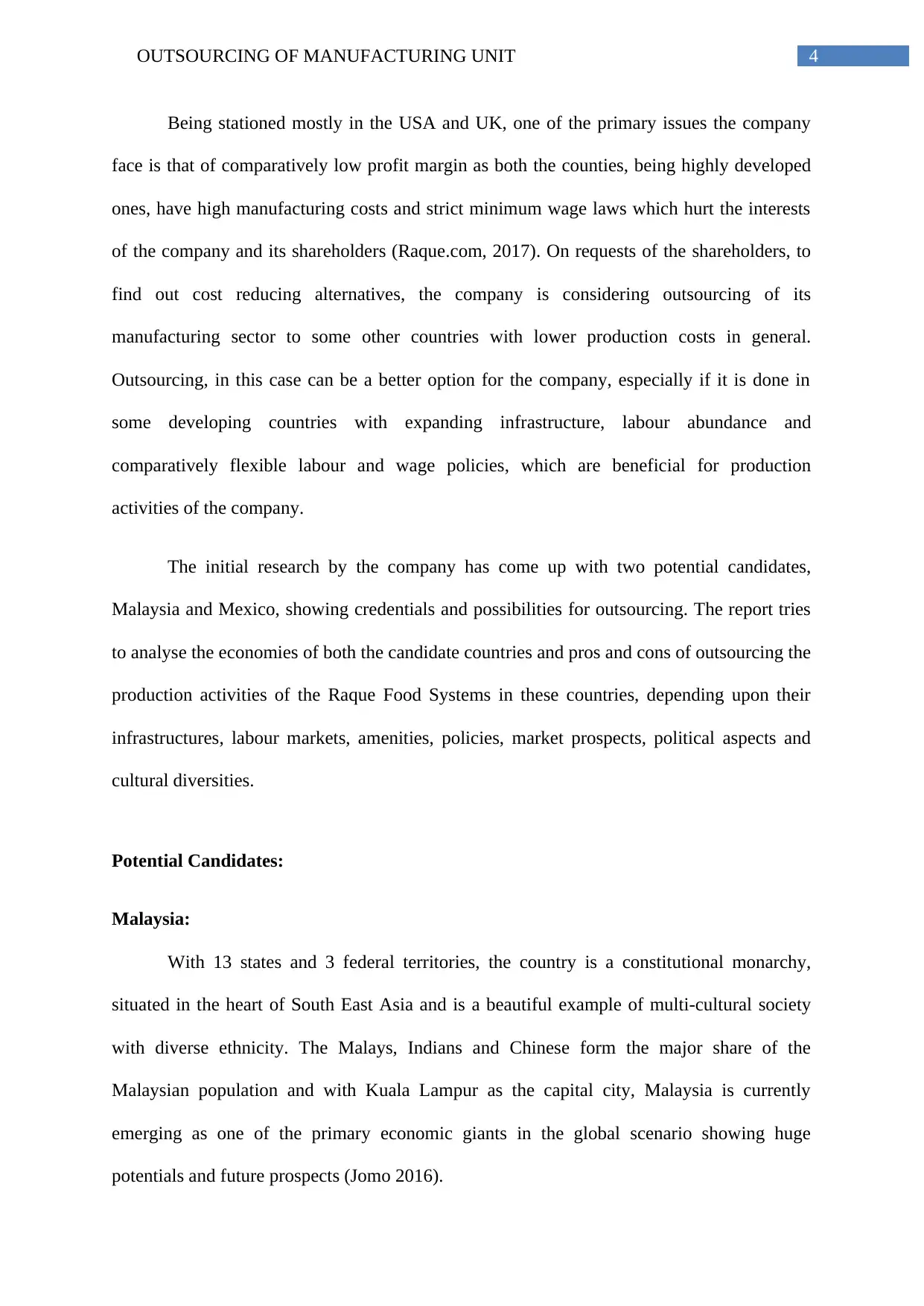
4OUTSOURCING OF MANUFACTURING UNIT
Being stationed mostly in the USA and UK, one of the primary issues the company
face is that of comparatively low profit margin as both the counties, being highly developed
ones, have high manufacturing costs and strict minimum wage laws which hurt the interests
of the company and its shareholders (Raque.com, 2017). On requests of the shareholders, to
find out cost reducing alternatives, the company is considering outsourcing of its
manufacturing sector to some other countries with lower production costs in general.
Outsourcing, in this case can be a better option for the company, especially if it is done in
some developing countries with expanding infrastructure, labour abundance and
comparatively flexible labour and wage policies, which are beneficial for production
activities of the company.
The initial research by the company has come up with two potential candidates,
Malaysia and Mexico, showing credentials and possibilities for outsourcing. The report tries
to analyse the economies of both the candidate countries and pros and cons of outsourcing the
production activities of the Raque Food Systems in these countries, depending upon their
infrastructures, labour markets, amenities, policies, market prospects, political aspects and
cultural diversities.
Potential Candidates:
Malaysia:
With 13 states and 3 federal territories, the country is a constitutional monarchy,
situated in the heart of South East Asia and is a beautiful example of multi-cultural society
with diverse ethnicity. The Malays, Indians and Chinese form the major share of the
Malaysian population and with Kuala Lampur as the capital city, Malaysia is currently
emerging as one of the primary economic giants in the global scenario showing huge
potentials and future prospects (Jomo 2016).
Being stationed mostly in the USA and UK, one of the primary issues the company
face is that of comparatively low profit margin as both the counties, being highly developed
ones, have high manufacturing costs and strict minimum wage laws which hurt the interests
of the company and its shareholders (Raque.com, 2017). On requests of the shareholders, to
find out cost reducing alternatives, the company is considering outsourcing of its
manufacturing sector to some other countries with lower production costs in general.
Outsourcing, in this case can be a better option for the company, especially if it is done in
some developing countries with expanding infrastructure, labour abundance and
comparatively flexible labour and wage policies, which are beneficial for production
activities of the company.
The initial research by the company has come up with two potential candidates,
Malaysia and Mexico, showing credentials and possibilities for outsourcing. The report tries
to analyse the economies of both the candidate countries and pros and cons of outsourcing the
production activities of the Raque Food Systems in these countries, depending upon their
infrastructures, labour markets, amenities, policies, market prospects, political aspects and
cultural diversities.
Potential Candidates:
Malaysia:
With 13 states and 3 federal territories, the country is a constitutional monarchy,
situated in the heart of South East Asia and is a beautiful example of multi-cultural society
with diverse ethnicity. The Malays, Indians and Chinese form the major share of the
Malaysian population and with Kuala Lampur as the capital city, Malaysia is currently
emerging as one of the primary economic giants in the global scenario showing huge
potentials and future prospects (Jomo 2016).
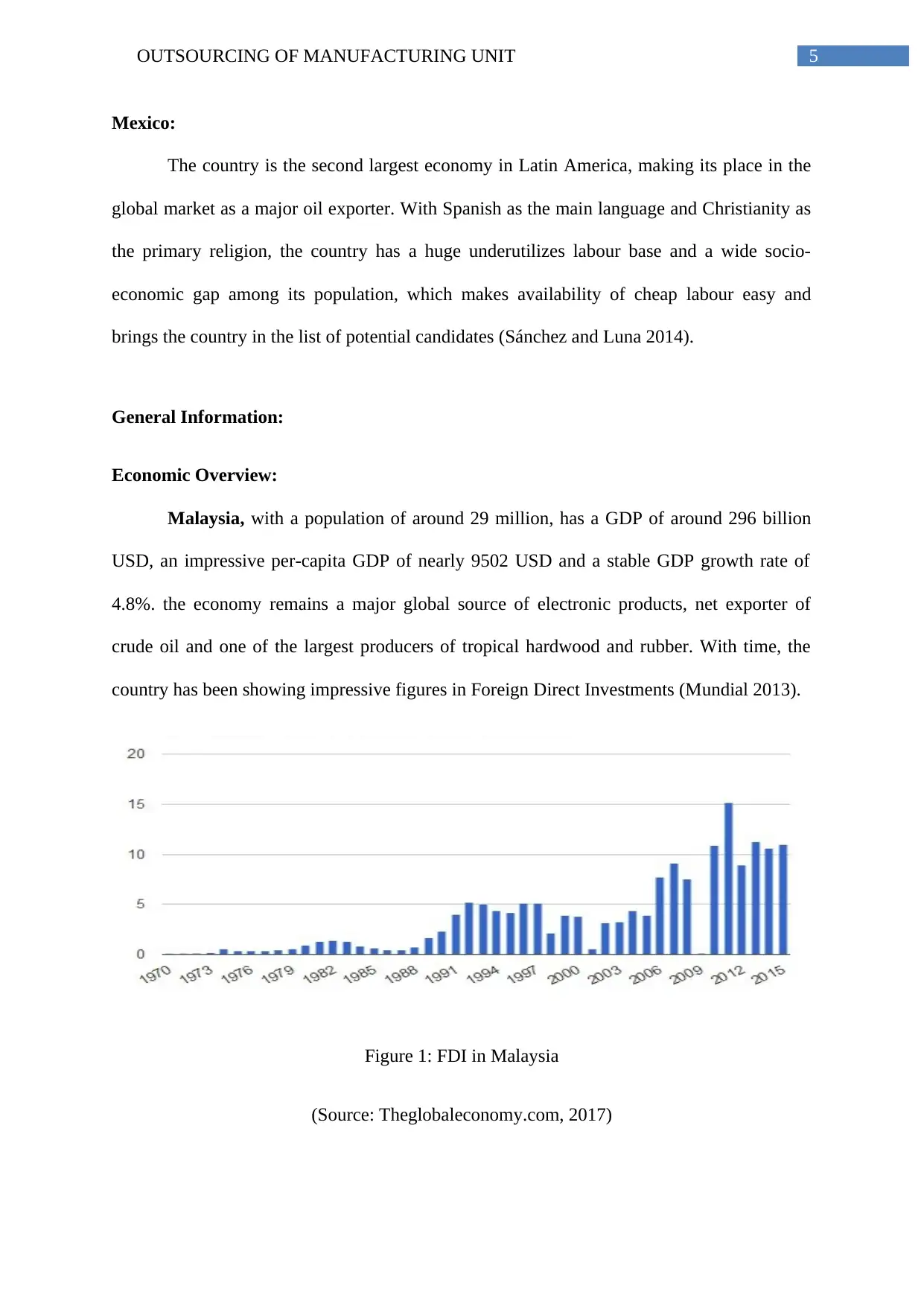
5OUTSOURCING OF MANUFACTURING UNIT
Mexico:
The country is the second largest economy in Latin America, making its place in the
global market as a major oil exporter. With Spanish as the main language and Christianity as
the primary religion, the country has a huge underutilizes labour base and a wide socio-
economic gap among its population, which makes availability of cheap labour easy and
brings the country in the list of potential candidates (Sánchez and Luna 2014).
General Information:
Economic Overview:
Malaysia, with a population of around 29 million, has a GDP of around 296 billion
USD, an impressive per-capita GDP of nearly 9502 USD and a stable GDP growth rate of
4.8%. the economy remains a major global source of electronic products, net exporter of
crude oil and one of the largest producers of tropical hardwood and rubber. With time, the
country has been showing impressive figures in Foreign Direct Investments (Mundial 2013).
Figure 1: FDI in Malaysia
(Source: Theglobaleconomy.com, 2017)
Mexico:
The country is the second largest economy in Latin America, making its place in the
global market as a major oil exporter. With Spanish as the main language and Christianity as
the primary religion, the country has a huge underutilizes labour base and a wide socio-
economic gap among its population, which makes availability of cheap labour easy and
brings the country in the list of potential candidates (Sánchez and Luna 2014).
General Information:
Economic Overview:
Malaysia, with a population of around 29 million, has a GDP of around 296 billion
USD, an impressive per-capita GDP of nearly 9502 USD and a stable GDP growth rate of
4.8%. the economy remains a major global source of electronic products, net exporter of
crude oil and one of the largest producers of tropical hardwood and rubber. With time, the
country has been showing impressive figures in Foreign Direct Investments (Mundial 2013).
Figure 1: FDI in Malaysia
(Source: Theglobaleconomy.com, 2017)
⊘ This is a preview!⊘
Do you want full access?
Subscribe today to unlock all pages.

Trusted by 1+ million students worldwide
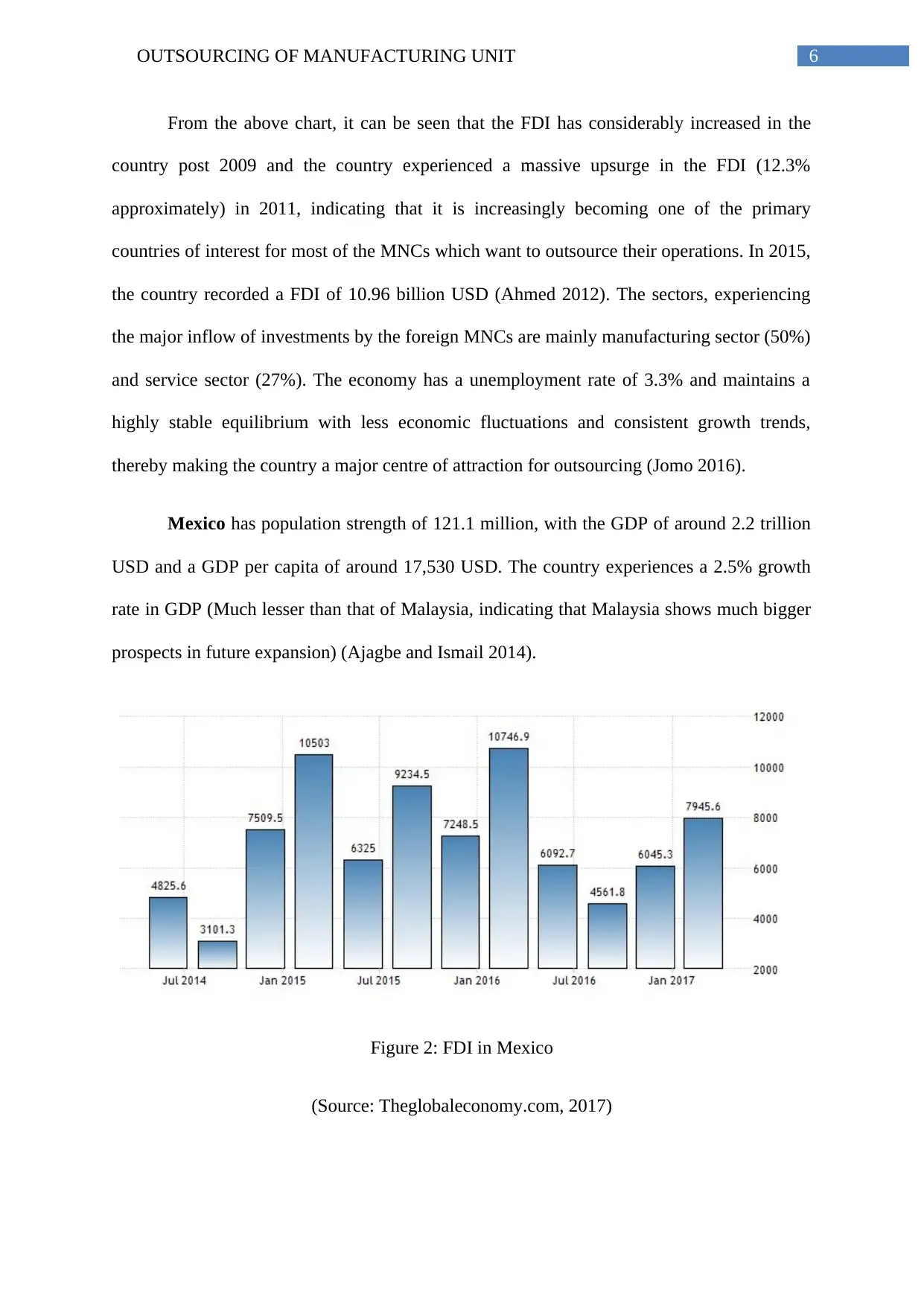
6OUTSOURCING OF MANUFACTURING UNIT
From the above chart, it can be seen that the FDI has considerably increased in the
country post 2009 and the country experienced a massive upsurge in the FDI (12.3%
approximately) in 2011, indicating that it is increasingly becoming one of the primary
countries of interest for most of the MNCs which want to outsource their operations. In 2015,
the country recorded a FDI of 10.96 billion USD (Ahmed 2012). The sectors, experiencing
the major inflow of investments by the foreign MNCs are mainly manufacturing sector (50%)
and service sector (27%). The economy has a unemployment rate of 3.3% and maintains a
highly stable equilibrium with less economic fluctuations and consistent growth trends,
thereby making the country a major centre of attraction for outsourcing (Jomo 2016).
Mexico has population strength of 121.1 million, with the GDP of around 2.2 trillion
USD and a GDP per capita of around 17,530 USD. The country experiences a 2.5% growth
rate in GDP (Much lesser than that of Malaysia, indicating that Malaysia shows much bigger
prospects in future expansion) (Ajagbe and Ismail 2014).
Figure 2: FDI in Mexico
(Source: Theglobaleconomy.com, 2017)
From the above chart, it can be seen that the FDI has considerably increased in the
country post 2009 and the country experienced a massive upsurge in the FDI (12.3%
approximately) in 2011, indicating that it is increasingly becoming one of the primary
countries of interest for most of the MNCs which want to outsource their operations. In 2015,
the country recorded a FDI of 10.96 billion USD (Ahmed 2012). The sectors, experiencing
the major inflow of investments by the foreign MNCs are mainly manufacturing sector (50%)
and service sector (27%). The economy has a unemployment rate of 3.3% and maintains a
highly stable equilibrium with less economic fluctuations and consistent growth trends,
thereby making the country a major centre of attraction for outsourcing (Jomo 2016).
Mexico has population strength of 121.1 million, with the GDP of around 2.2 trillion
USD and a GDP per capita of around 17,530 USD. The country experiences a 2.5% growth
rate in GDP (Much lesser than that of Malaysia, indicating that Malaysia shows much bigger
prospects in future expansion) (Ajagbe and Ismail 2014).
Figure 2: FDI in Mexico
(Source: Theglobaleconomy.com, 2017)
Paraphrase This Document
Need a fresh take? Get an instant paraphrase of this document with our AI Paraphraser
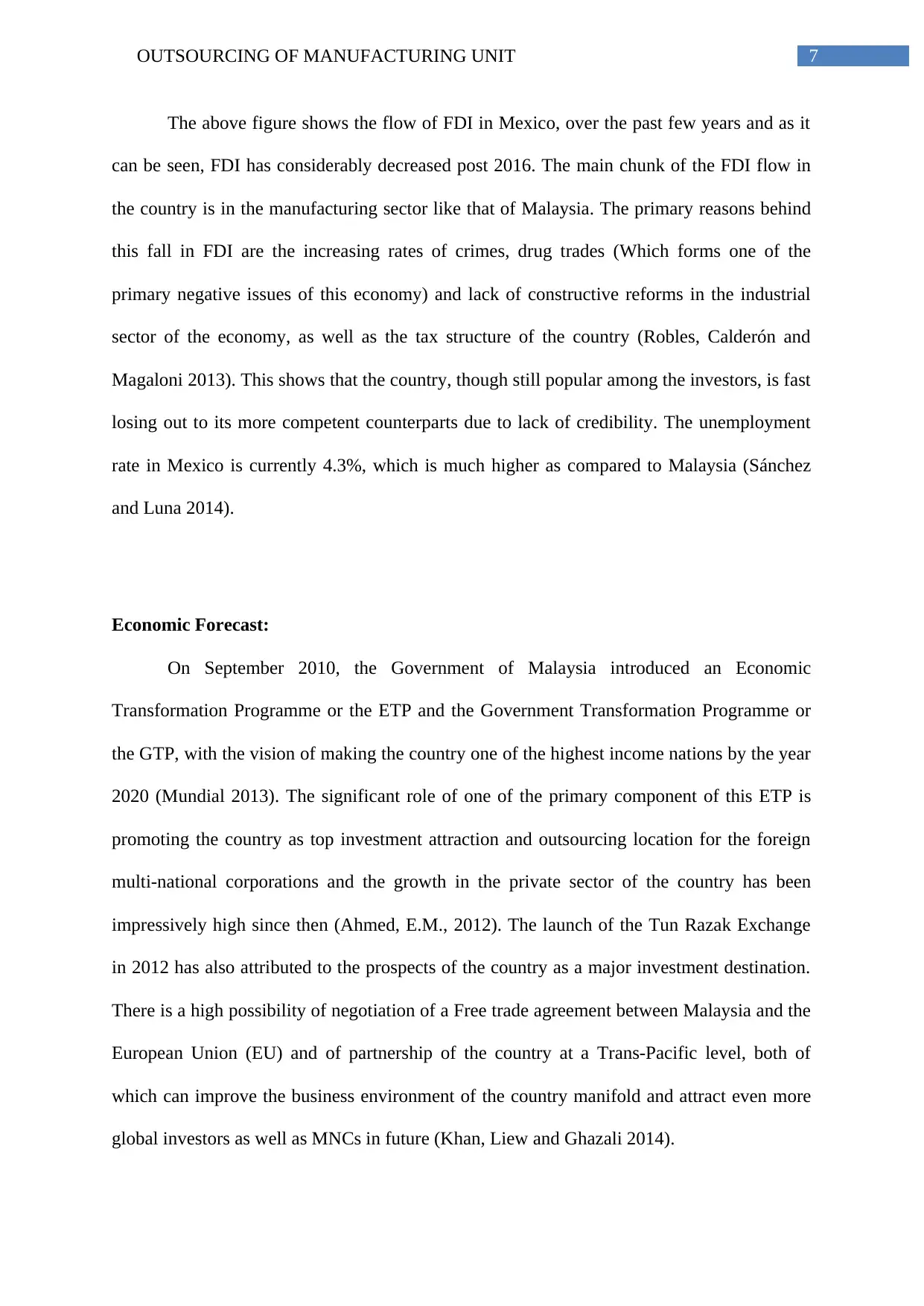
7OUTSOURCING OF MANUFACTURING UNIT
The above figure shows the flow of FDI in Mexico, over the past few years and as it
can be seen, FDI has considerably decreased post 2016. The main chunk of the FDI flow in
the country is in the manufacturing sector like that of Malaysia. The primary reasons behind
this fall in FDI are the increasing rates of crimes, drug trades (Which forms one of the
primary negative issues of this economy) and lack of constructive reforms in the industrial
sector of the economy, as well as the tax structure of the country (Robles, Calderón and
Magaloni 2013). This shows that the country, though still popular among the investors, is fast
losing out to its more competent counterparts due to lack of credibility. The unemployment
rate in Mexico is currently 4.3%, which is much higher as compared to Malaysia (Sánchez
and Luna 2014).
Economic Forecast:
On September 2010, the Government of Malaysia introduced an Economic
Transformation Programme or the ETP and the Government Transformation Programme or
the GTP, with the vision of making the country one of the highest income nations by the year
2020 (Mundial 2013). The significant role of one of the primary component of this ETP is
promoting the country as top investment attraction and outsourcing location for the foreign
multi-national corporations and the growth in the private sector of the country has been
impressively high since then (Ahmed, E.M., 2012). The launch of the Tun Razak Exchange
in 2012 has also attributed to the prospects of the country as a major investment destination.
There is a high possibility of negotiation of a Free trade agreement between Malaysia and the
European Union (EU) and of partnership of the country at a Trans-Pacific level, both of
which can improve the business environment of the country manifold and attract even more
global investors as well as MNCs in future (Khan, Liew and Ghazali 2014).
The above figure shows the flow of FDI in Mexico, over the past few years and as it
can be seen, FDI has considerably decreased post 2016. The main chunk of the FDI flow in
the country is in the manufacturing sector like that of Malaysia. The primary reasons behind
this fall in FDI are the increasing rates of crimes, drug trades (Which forms one of the
primary negative issues of this economy) and lack of constructive reforms in the industrial
sector of the economy, as well as the tax structure of the country (Robles, Calderón and
Magaloni 2013). This shows that the country, though still popular among the investors, is fast
losing out to its more competent counterparts due to lack of credibility. The unemployment
rate in Mexico is currently 4.3%, which is much higher as compared to Malaysia (Sánchez
and Luna 2014).
Economic Forecast:
On September 2010, the Government of Malaysia introduced an Economic
Transformation Programme or the ETP and the Government Transformation Programme or
the GTP, with the vision of making the country one of the highest income nations by the year
2020 (Mundial 2013). The significant role of one of the primary component of this ETP is
promoting the country as top investment attraction and outsourcing location for the foreign
multi-national corporations and the growth in the private sector of the country has been
impressively high since then (Ahmed, E.M., 2012). The launch of the Tun Razak Exchange
in 2012 has also attributed to the prospects of the country as a major investment destination.
There is a high possibility of negotiation of a Free trade agreement between Malaysia and the
European Union (EU) and of partnership of the country at a Trans-Pacific level, both of
which can improve the business environment of the country manifold and attract even more
global investors as well as MNCs in future (Khan, Liew and Ghazali 2014).
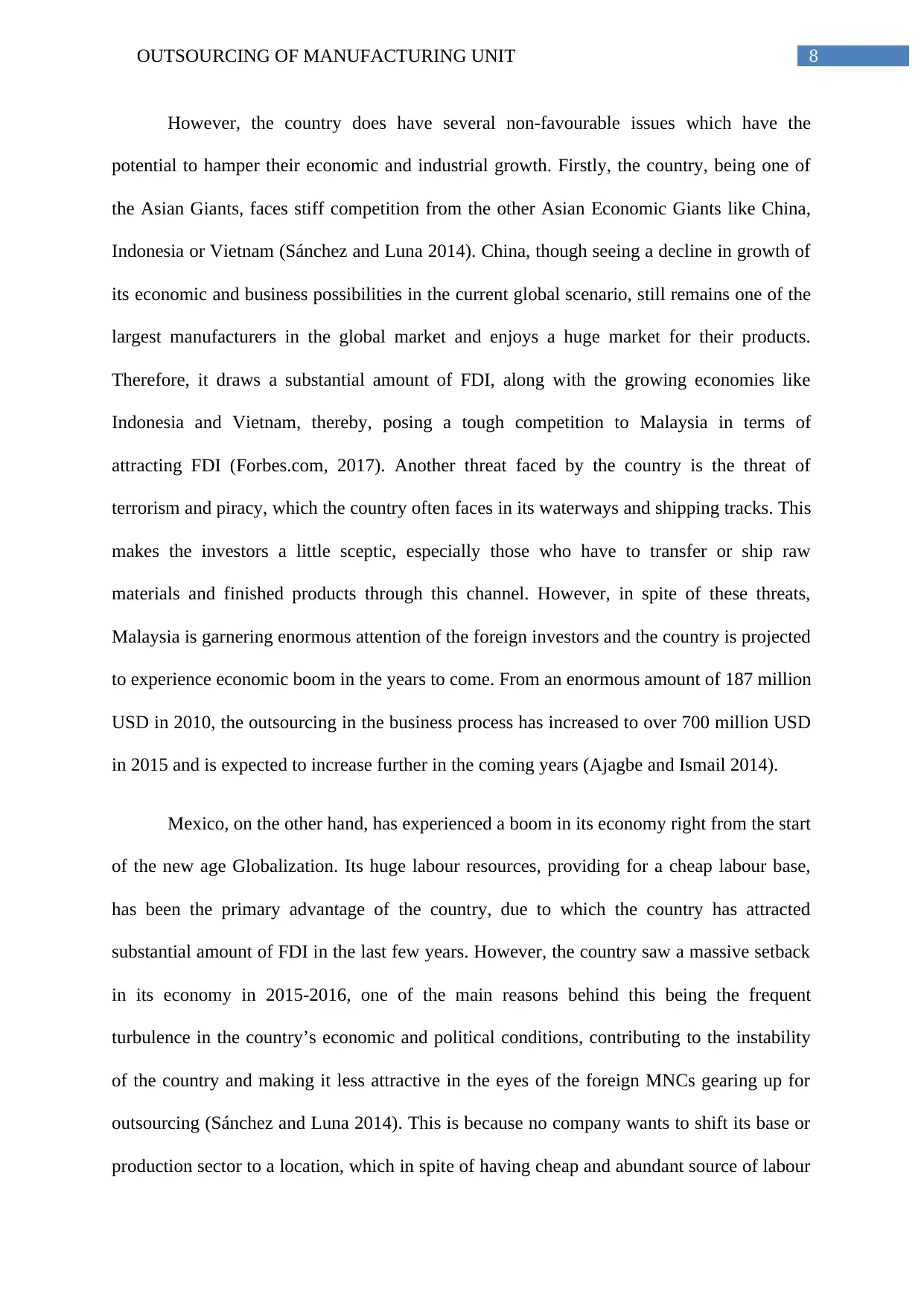
8OUTSOURCING OF MANUFACTURING UNIT
However, the country does have several non-favourable issues which have the
potential to hamper their economic and industrial growth. Firstly, the country, being one of
the Asian Giants, faces stiff competition from the other Asian Economic Giants like China,
Indonesia or Vietnam (Sánchez and Luna 2014). China, though seeing a decline in growth of
its economic and business possibilities in the current global scenario, still remains one of the
largest manufacturers in the global market and enjoys a huge market for their products.
Therefore, it draws a substantial amount of FDI, along with the growing economies like
Indonesia and Vietnam, thereby, posing a tough competition to Malaysia in terms of
attracting FDI (Forbes.com, 2017). Another threat faced by the country is the threat of
terrorism and piracy, which the country often faces in its waterways and shipping tracks. This
makes the investors a little sceptic, especially those who have to transfer or ship raw
materials and finished products through this channel. However, in spite of these threats,
Malaysia is garnering enormous attention of the foreign investors and the country is projected
to experience economic boom in the years to come. From an enormous amount of 187 million
USD in 2010, the outsourcing in the business process has increased to over 700 million USD
in 2015 and is expected to increase further in the coming years (Ajagbe and Ismail 2014).
Mexico, on the other hand, has experienced a boom in its economy right from the start
of the new age Globalization. Its huge labour resources, providing for a cheap labour base,
has been the primary advantage of the country, due to which the country has attracted
substantial amount of FDI in the last few years. However, the country saw a massive setback
in its economy in 2015-2016, one of the main reasons behind this being the frequent
turbulence in the country’s economic and political conditions, contributing to the instability
of the country and making it less attractive in the eyes of the foreign MNCs gearing up for
outsourcing (Sánchez and Luna 2014). This is because no company wants to shift its base or
production sector to a location, which in spite of having cheap and abundant source of labour
However, the country does have several non-favourable issues which have the
potential to hamper their economic and industrial growth. Firstly, the country, being one of
the Asian Giants, faces stiff competition from the other Asian Economic Giants like China,
Indonesia or Vietnam (Sánchez and Luna 2014). China, though seeing a decline in growth of
its economic and business possibilities in the current global scenario, still remains one of the
largest manufacturers in the global market and enjoys a huge market for their products.
Therefore, it draws a substantial amount of FDI, along with the growing economies like
Indonesia and Vietnam, thereby, posing a tough competition to Malaysia in terms of
attracting FDI (Forbes.com, 2017). Another threat faced by the country is the threat of
terrorism and piracy, which the country often faces in its waterways and shipping tracks. This
makes the investors a little sceptic, especially those who have to transfer or ship raw
materials and finished products through this channel. However, in spite of these threats,
Malaysia is garnering enormous attention of the foreign investors and the country is projected
to experience economic boom in the years to come. From an enormous amount of 187 million
USD in 2010, the outsourcing in the business process has increased to over 700 million USD
in 2015 and is expected to increase further in the coming years (Ajagbe and Ismail 2014).
Mexico, on the other hand, has experienced a boom in its economy right from the start
of the new age Globalization. Its huge labour resources, providing for a cheap labour base,
has been the primary advantage of the country, due to which the country has attracted
substantial amount of FDI in the last few years. However, the country saw a massive setback
in its economy in 2015-2016, one of the main reasons behind this being the frequent
turbulence in the country’s economic and political conditions, contributing to the instability
of the country and making it less attractive in the eyes of the foreign MNCs gearing up for
outsourcing (Sánchez and Luna 2014). This is because no company wants to shift its base or
production sector to a location, which in spite of having cheap and abundant source of labour
⊘ This is a preview!⊘
Do you want full access?
Subscribe today to unlock all pages.

Trusted by 1+ million students worldwide
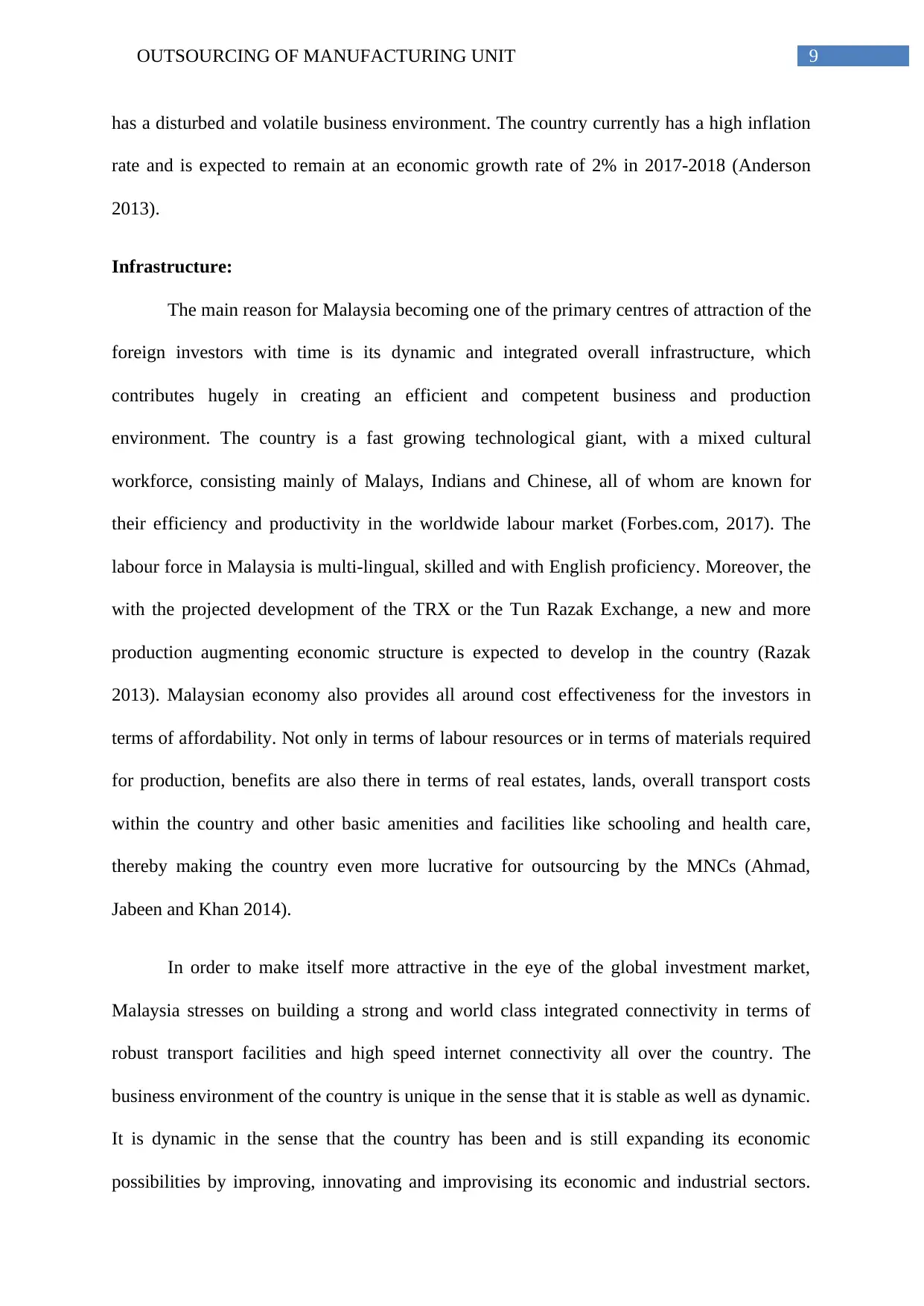
9OUTSOURCING OF MANUFACTURING UNIT
has a disturbed and volatile business environment. The country currently has a high inflation
rate and is expected to remain at an economic growth rate of 2% in 2017-2018 (Anderson
2013).
Infrastructure:
The main reason for Malaysia becoming one of the primary centres of attraction of the
foreign investors with time is its dynamic and integrated overall infrastructure, which
contributes hugely in creating an efficient and competent business and production
environment. The country is a fast growing technological giant, with a mixed cultural
workforce, consisting mainly of Malays, Indians and Chinese, all of whom are known for
their efficiency and productivity in the worldwide labour market (Forbes.com, 2017). The
labour force in Malaysia is multi-lingual, skilled and with English proficiency. Moreover, the
with the projected development of the TRX or the Tun Razak Exchange, a new and more
production augmenting economic structure is expected to develop in the country (Razak
2013). Malaysian economy also provides all around cost effectiveness for the investors in
terms of affordability. Not only in terms of labour resources or in terms of materials required
for production, benefits are also there in terms of real estates, lands, overall transport costs
within the country and other basic amenities and facilities like schooling and health care,
thereby making the country even more lucrative for outsourcing by the MNCs (Ahmad,
Jabeen and Khan 2014).
In order to make itself more attractive in the eye of the global investment market,
Malaysia stresses on building a strong and world class integrated connectivity in terms of
robust transport facilities and high speed internet connectivity all over the country. The
business environment of the country is unique in the sense that it is stable as well as dynamic.
It is dynamic in the sense that the country has been and is still expanding its economic
possibilities by improving, innovating and improvising its economic and industrial sectors.
has a disturbed and volatile business environment. The country currently has a high inflation
rate and is expected to remain at an economic growth rate of 2% in 2017-2018 (Anderson
2013).
Infrastructure:
The main reason for Malaysia becoming one of the primary centres of attraction of the
foreign investors with time is its dynamic and integrated overall infrastructure, which
contributes hugely in creating an efficient and competent business and production
environment. The country is a fast growing technological giant, with a mixed cultural
workforce, consisting mainly of Malays, Indians and Chinese, all of whom are known for
their efficiency and productivity in the worldwide labour market (Forbes.com, 2017). The
labour force in Malaysia is multi-lingual, skilled and with English proficiency. Moreover, the
with the projected development of the TRX or the Tun Razak Exchange, a new and more
production augmenting economic structure is expected to develop in the country (Razak
2013). Malaysian economy also provides all around cost effectiveness for the investors in
terms of affordability. Not only in terms of labour resources or in terms of materials required
for production, benefits are also there in terms of real estates, lands, overall transport costs
within the country and other basic amenities and facilities like schooling and health care,
thereby making the country even more lucrative for outsourcing by the MNCs (Ahmad,
Jabeen and Khan 2014).
In order to make itself more attractive in the eye of the global investment market,
Malaysia stresses on building a strong and world class integrated connectivity in terms of
robust transport facilities and high speed internet connectivity all over the country. The
business environment of the country is unique in the sense that it is stable as well as dynamic.
It is dynamic in the sense that the country has been and is still expanding its economic
possibilities by improving, innovating and improvising its economic and industrial sectors.
Paraphrase This Document
Need a fresh take? Get an instant paraphrase of this document with our AI Paraphraser
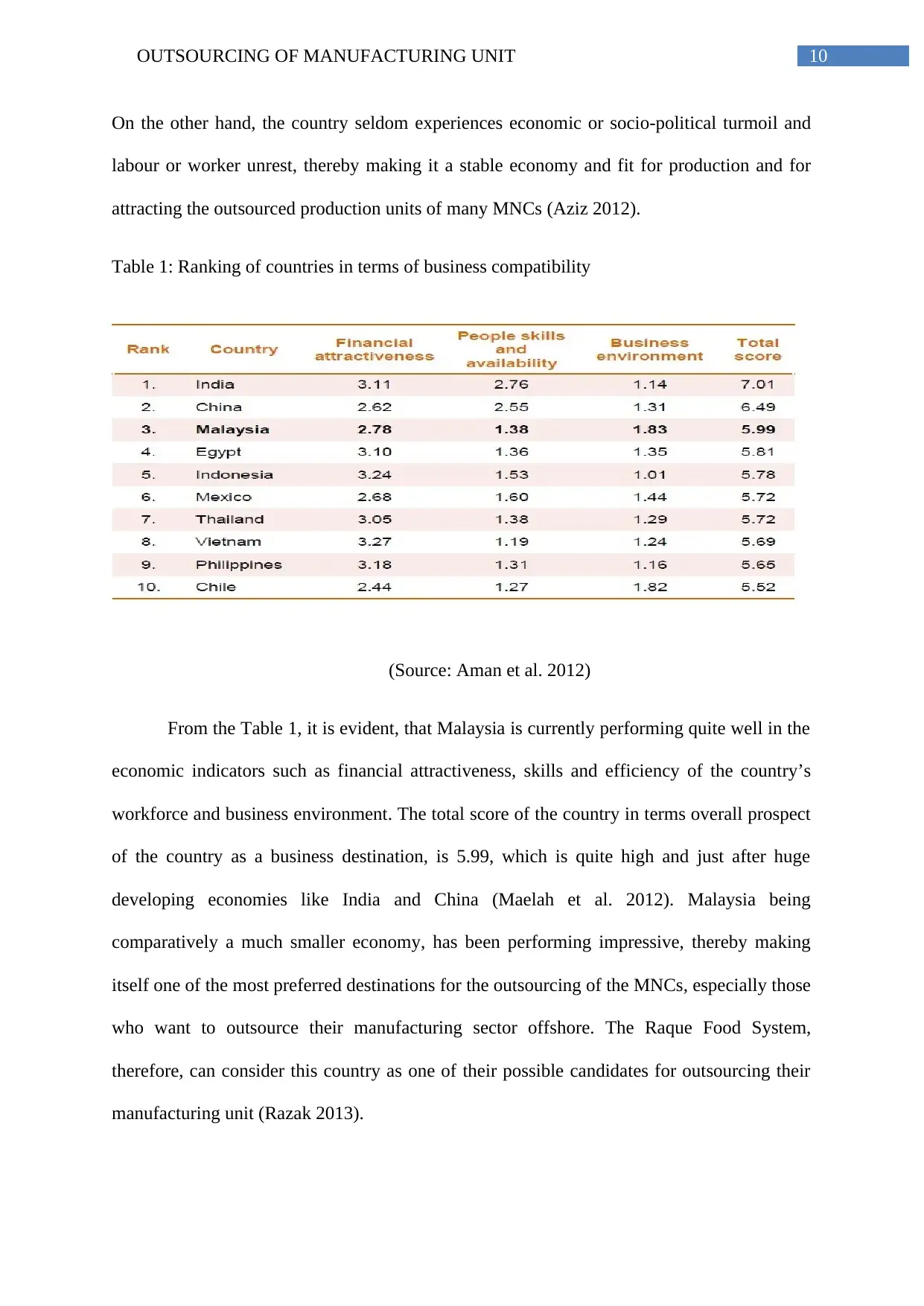
10OUTSOURCING OF MANUFACTURING UNIT
On the other hand, the country seldom experiences economic or socio-political turmoil and
labour or worker unrest, thereby making it a stable economy and fit for production and for
attracting the outsourced production units of many MNCs (Aziz 2012).
Table 1: Ranking of countries in terms of business compatibility
(Source: Aman et al. 2012)
From the Table 1, it is evident, that Malaysia is currently performing quite well in the
economic indicators such as financial attractiveness, skills and efficiency of the country’s
workforce and business environment. The total score of the country in terms overall prospect
of the country as a business destination, is 5.99, which is quite high and just after huge
developing economies like India and China (Maelah et al. 2012). Malaysia being
comparatively a much smaller economy, has been performing impressive, thereby making
itself one of the most preferred destinations for the outsourcing of the MNCs, especially those
who want to outsource their manufacturing sector offshore. The Raque Food System,
therefore, can consider this country as one of their possible candidates for outsourcing their
manufacturing unit (Razak 2013).
On the other hand, the country seldom experiences economic or socio-political turmoil and
labour or worker unrest, thereby making it a stable economy and fit for production and for
attracting the outsourced production units of many MNCs (Aziz 2012).
Table 1: Ranking of countries in terms of business compatibility
(Source: Aman et al. 2012)
From the Table 1, it is evident, that Malaysia is currently performing quite well in the
economic indicators such as financial attractiveness, skills and efficiency of the country’s
workforce and business environment. The total score of the country in terms overall prospect
of the country as a business destination, is 5.99, which is quite high and just after huge
developing economies like India and China (Maelah et al. 2012). Malaysia being
comparatively a much smaller economy, has been performing impressive, thereby making
itself one of the most preferred destinations for the outsourcing of the MNCs, especially those
who want to outsource their manufacturing sector offshore. The Raque Food System,
therefore, can consider this country as one of their possible candidates for outsourcing their
manufacturing unit (Razak 2013).
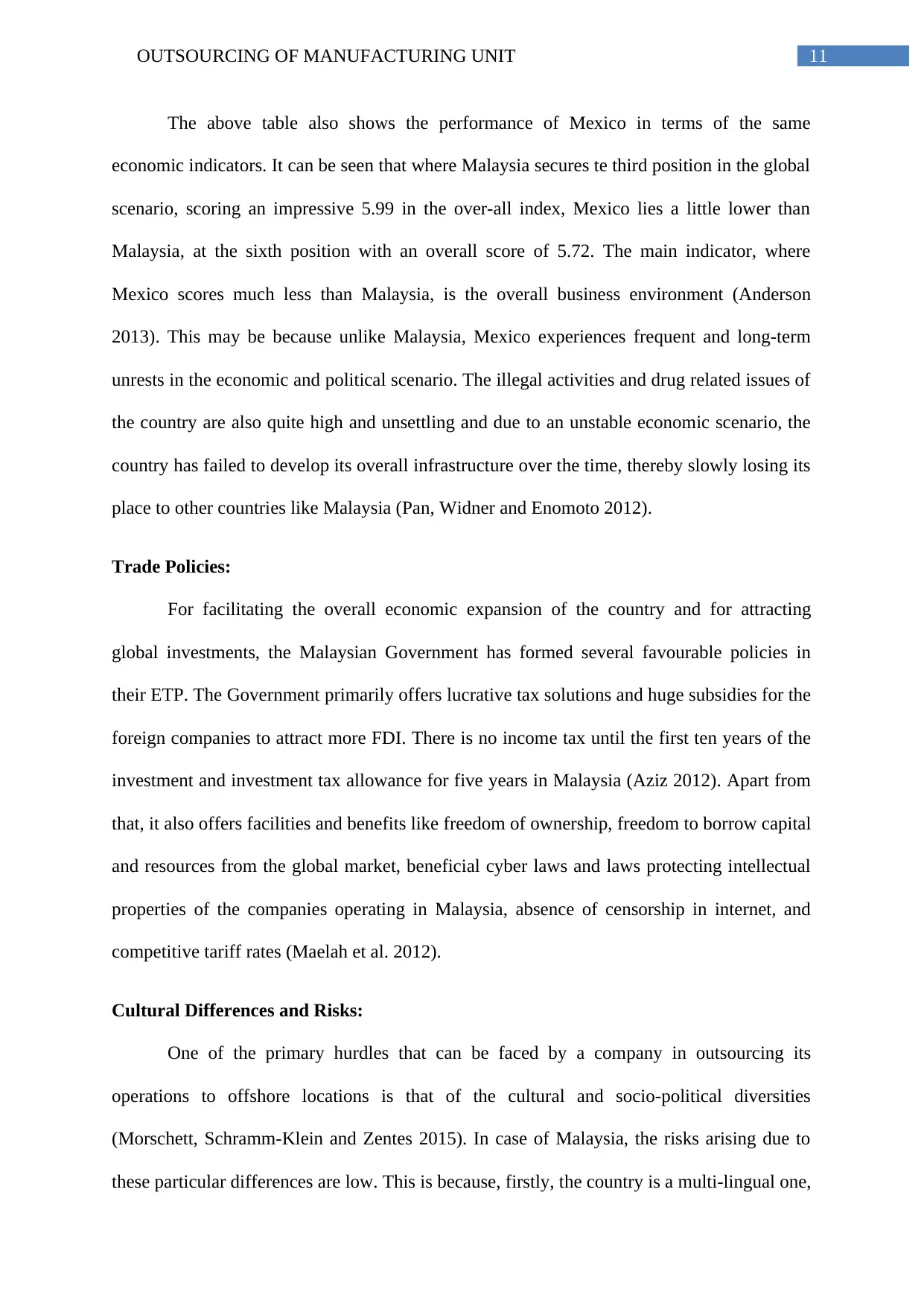
11OUTSOURCING OF MANUFACTURING UNIT
The above table also shows the performance of Mexico in terms of the same
economic indicators. It can be seen that where Malaysia secures te third position in the global
scenario, scoring an impressive 5.99 in the over-all index, Mexico lies a little lower than
Malaysia, at the sixth position with an overall score of 5.72. The main indicator, where
Mexico scores much less than Malaysia, is the overall business environment (Anderson
2013). This may be because unlike Malaysia, Mexico experiences frequent and long-term
unrests in the economic and political scenario. The illegal activities and drug related issues of
the country are also quite high and unsettling and due to an unstable economic scenario, the
country has failed to develop its overall infrastructure over the time, thereby slowly losing its
place to other countries like Malaysia (Pan, Widner and Enomoto 2012).
Trade Policies:
For facilitating the overall economic expansion of the country and for attracting
global investments, the Malaysian Government has formed several favourable policies in
their ETP. The Government primarily offers lucrative tax solutions and huge subsidies for the
foreign companies to attract more FDI. There is no income tax until the first ten years of the
investment and investment tax allowance for five years in Malaysia (Aziz 2012). Apart from
that, it also offers facilities and benefits like freedom of ownership, freedom to borrow capital
and resources from the global market, beneficial cyber laws and laws protecting intellectual
properties of the companies operating in Malaysia, absence of censorship in internet, and
competitive tariff rates (Maelah et al. 2012).
Cultural Differences and Risks:
One of the primary hurdles that can be faced by a company in outsourcing its
operations to offshore locations is that of the cultural and socio-political diversities
(Morschett, Schramm-Klein and Zentes 2015). In case of Malaysia, the risks arising due to
these particular differences are low. This is because, firstly, the country is a multi-lingual one,
The above table also shows the performance of Mexico in terms of the same
economic indicators. It can be seen that where Malaysia secures te third position in the global
scenario, scoring an impressive 5.99 in the over-all index, Mexico lies a little lower than
Malaysia, at the sixth position with an overall score of 5.72. The main indicator, where
Mexico scores much less than Malaysia, is the overall business environment (Anderson
2013). This may be because unlike Malaysia, Mexico experiences frequent and long-term
unrests in the economic and political scenario. The illegal activities and drug related issues of
the country are also quite high and unsettling and due to an unstable economic scenario, the
country has failed to develop its overall infrastructure over the time, thereby slowly losing its
place to other countries like Malaysia (Pan, Widner and Enomoto 2012).
Trade Policies:
For facilitating the overall economic expansion of the country and for attracting
global investments, the Malaysian Government has formed several favourable policies in
their ETP. The Government primarily offers lucrative tax solutions and huge subsidies for the
foreign companies to attract more FDI. There is no income tax until the first ten years of the
investment and investment tax allowance for five years in Malaysia (Aziz 2012). Apart from
that, it also offers facilities and benefits like freedom of ownership, freedom to borrow capital
and resources from the global market, beneficial cyber laws and laws protecting intellectual
properties of the companies operating in Malaysia, absence of censorship in internet, and
competitive tariff rates (Maelah et al. 2012).
Cultural Differences and Risks:
One of the primary hurdles that can be faced by a company in outsourcing its
operations to offshore locations is that of the cultural and socio-political diversities
(Morschett, Schramm-Klein and Zentes 2015). In case of Malaysia, the risks arising due to
these particular differences are low. This is because, firstly, the country is a multi-lingual one,
⊘ This is a preview!⊘
Do you want full access?
Subscribe today to unlock all pages.

Trusted by 1+ million students worldwide
1 out of 17
Related Documents
Your All-in-One AI-Powered Toolkit for Academic Success.
+13062052269
info@desklib.com
Available 24*7 on WhatsApp / Email
![[object Object]](/_next/static/media/star-bottom.7253800d.svg)
Unlock your academic potential
Copyright © 2020–2025 A2Z Services. All Rights Reserved. Developed and managed by ZUCOL.



